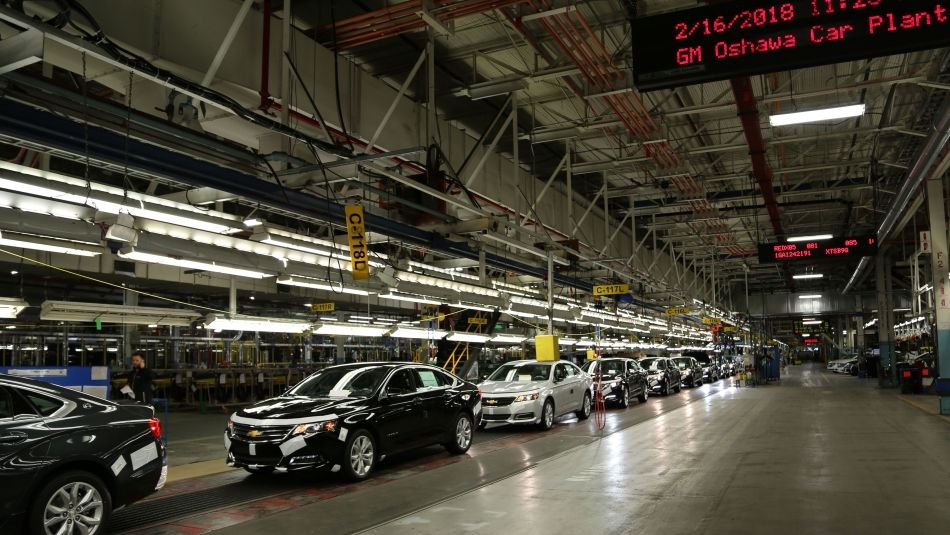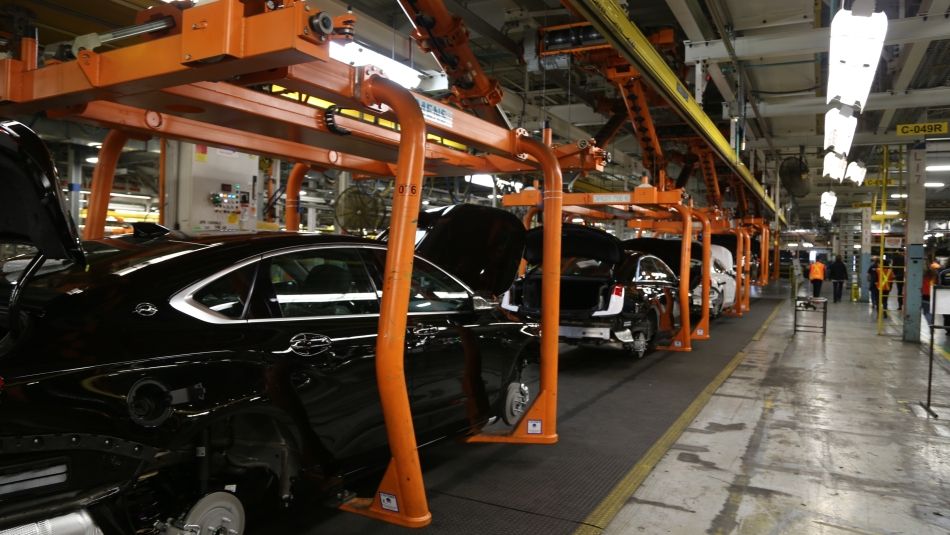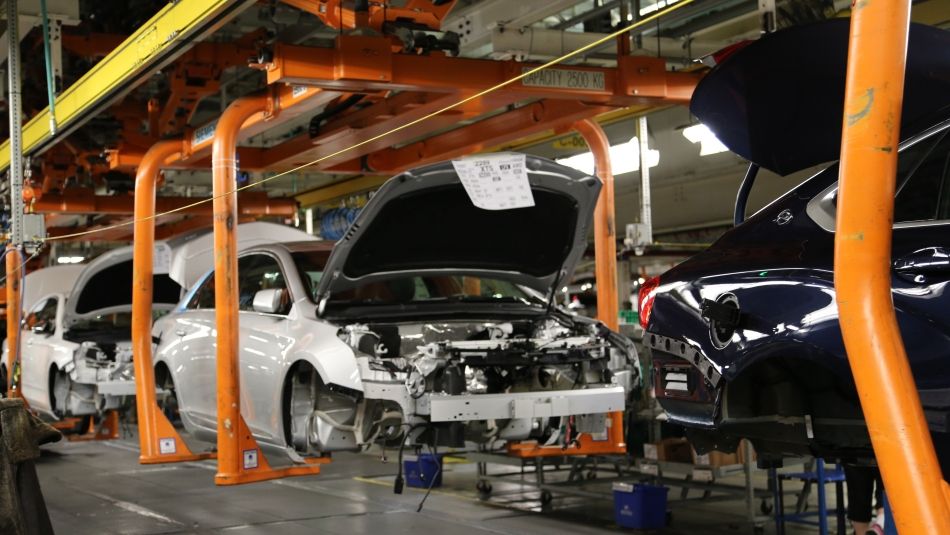
Share
Unifor statement on the recent announcement from General Motors
On November 26, 2018, General Motors (GM) announced restructuring plans that would help it “accelerate transformation” of the company toward future technologies and “stay in front of changing market conditions and consumer preferences.” The main outcome of the restructuring plans is that the Oshawa plant, along with two U.S. assembly plants and two smaller U.S. transmission operations, will have no product allocation beyond December 2019. Oshawa accounts for 45% of the workers affected by these restructuring plans.
We do not accept any plans to close GM Oshawa
Unifor does not accept any restructuring plans that will result in the closure of the Oshawa operations. The company has framed these plans as being about moving toward new technology, and focusing on electric and autonomous vehicles. Although Unifor supports all auto companies in their efforts to adapt their business model with an eye to the future, there is no justification—whatsoever—for implementing plans that result in the closure of highly productive and flexible plants, like Oshawa, in order to accomplish these goals.
GM’s plans were unveiled not in a declining market, or because the company faces a dire financial position—the U.S. market for vehicles remains at peak levels, with sales expected above 17 million units again this year, and Canadian sales will yet again top 2 million this year. GM is performing very strongly, reaping $US 6 billion in profits in the first nine months of 2018 alone.1 These are good times in the industry, which means that GM has many options available to pursue its transformation other than closing existing plants.
Any plans that result in Oshawa being “unallocated” next year are completely contrary to the binding commitments made by GM in our 2016 negotiations with the company. GM committed in the collective agreement to keeping our plants open:
Plant Closing Moratorium: As a result of your deep concern about job security in our negotiations and the many discussions which took place over it, this will confirm that during the term of the new Master Agreement, until September 21, 2020, the Company will not, except as otherwise agreed to by the parties, close or sell any plant or ongoing business, in whole or in part, covered by this Agreement. (General Motors of Canada and Unifor 2016 Master Collective Agreement, p. 384)
Under the terms of the agreement, GM has an obligation to keep the Oshawa plant open until September 21, 2020—at a minimum—at which time we will have an opportunity to sit down and discuss any restructuring plans during negotiations. Since its announcement this week, GM has clarified that the “unallocated” plants in the U.S. will not be closed but rather “idled,” subject to negotiations with the UAW next fall.2 As a first step in Canada, we expect that the company will meet its legal obligations under the collective agreement.
Ultimately, efforts to enact these plans serve as a betrayal of those workers who have delivered the highest-quality work for the company for decades. Despite efforts to frame these plans as being about the future, the end result would be to wind down more production in Canada and the U.S. while continuing to boost production in Mexico. Sadly, this is not about a shining future, but about pursuing an outdated vision based on cheap labour and short-term profits.
GM Oshawa has earned the right to a strong future
At every turn, over many decades, the members of Unifor Local 222 at GM Oshawa have delivered for the company. Oshawa has been building cars for over 100 years. Whether through several rounds of restructuring and uncertainty, or by launching new products and implementing major investments, the workers at GM Oshawa have always reached the very highest levels of quality and productivity. The members of Unifor Local 222 are justifiably proud of their record.
The plant, and the products built there, have received countless quality awards, including four gold and four silver J.D. Power awards in the organization’s annual review of automakers and production plants around the world. Oshawa also performed the best for all of GM’s Chevrolet products in Consumers Reports, with the Impala; and best within the company’s Cadillac products with the XTS.
The plant often leads measures of workforce productivity, including, most recently, in the 2015 Harbour Report, capturing the top spot in three out of the five vehicle segments in which the plant operates.
This is what GM has to say about the plant:
Oshawa Assembly is the most decorated plant with 29 J.D. Power awards, a proven track record of great quality and customer satisfaction. In 2014 Oshawa was recognized as the most complex facility in North America building several models and options on the Flex Line while also running a Consolidated Line within one plant.3
Just this year GM awarded Oshawa its highest internal quality recognition, BIQ 4; only one of four assembly plants within North America from a population of eighteen plants, the only Canadian plant with this award currently. GM Oshawa is among the most flexible auto plants in the world, specifically designed to produce many different models at the same time. It is the only operation in North America capable of building both cars and pickup trucks in the same plant. When Silverado and Sierra truck production resumed this year, the plant was soon operating at the highest level of quality among all GM truck plants. And GM Oshawa as one of the most advanced and best paint shops in the world.
The company says it needs to transform toward higher levels of technology to meet the needs of the future. If that is the case, it makes sense to put those investments in the hands of the workforce most capable of delivering the best results—in Oshawa.
This matters to everyone
Good jobs in the auto sector are important—and their impact stretches well beyond the lives of the 2,900 production and salaried workers at GM Oshawa: the benefits spread far and wide. The spin-off effects of the industry through the purchase of auto parts, the use of raw materials, and the effects of workers’ spending mean that every job in auto assembly creates seven other jobs across the economy.
Independent research conducted in 2015 revealed that the economic activity of the GM Oshawa operations at that time were responsible for 30,000 jobs in the wider economy, and generated over $1 billion per year in public revenue.4 An expanded study from 2016, which examined the economic impact of the Canadian manufacturing operations of GM, Ford, and FCA, found that they resulted in a $4.7 billion annual contribution to the public purse.5
If you care about the health of the economy, good jobs, quality health care, excellent educational opportunities, and strong public services, then you need to care about the future of the auto industry in Canada.
What’s Mexico got to do with this?
GM has noted that the restructuring plans will result in $US 6 billion in cost reductions, allowing the company to focus on future product development. GM can put all the spin it wants around a future focused on autonomous and electric vehicles, but the way these plans are structured has only one clear outcome: a further reduction of production in Canada and the U.S., while the company continues to shift investment and good jobs to Mexico.
GM is not planning to sell significantly fewer vehicles in North America over the coming years, and production forecasts show that the company intends to build even more vehicles in the years ahead in Mexico, and fewer in Canada and the United States.6
Five years ago, GM built essentially the same number of vehicles in Canada and Mexico (627,000 and 646,000, respectively). Since then, the company has steadily allocated products and shifted investment to Mexico, including all production of the GMC Terrain and increasing volumes of the Chevrolet Equinox, vehicles that were previously built exclusively in Canada. GM announced its plans in 2014 plans to double capacity in Mexico, a development that we warned about as having grave consequences for Canada.7
In 2020 GM is forecast to build 938,000 vehicles in Mexico—a 45% increase compared to just five years ago. If GM were to shut down the Oshawa plant, GM production in Canada is expected to fall to 194,000 vehicles in 2020—just one-fifth the number of vehicles the company will produce in Mexico.
Mexican autoworkers do not have the right to join a real trade union or to engage in free collective bargaining. Workers’ rights have been suppressed through collusion between government-aligned “unions” that offer sweetheart protection contracts to companies, usually without the workers ever signing up or seeing the contracts signed on their behalf. GM pays its autoworkers in Mexico an average of just $US 2 per hour.8
The newly negotiated free-trade agreement between Canada, the U.S., and Mexico (the USMCA) includes some measures to improve labour rights in Mexico, and provisions aimed at raising wages specifically in the Mexican auto sector. The newly elected president, Andrés Manuel López Obrador, campaigned on promises to improve conditions for workers. These developments are positive, but will take many years to take effect. In the meantime, GM is intent on maximizing the benefits of low wages and minimal rights for workers in Mexico.
Canada deserves better
GM does very well for itself in Canada. Not only do workers in the company’s plants in Oshawa, Ingersoll, and St. Catharines produce top-quality and lucrative vehicles, engines, and transmissions, but the company also sells a lot of vehicles in Canada—more than 300,000 last year.
Canada will never be as important to GM as its number-one market, China, or its number-two market, the United States. But, after Brazil, Canada is GM’s fourth-largest global market—at average prices, GM’s sales in Canada are worth well over $10 billion each year.9
GM regularly talks about “building where you sell” to justify its expansion overseas or in Mexico, instead of sending exports from Canada or the United States. But that’s not what the company actually does in North America. This year, Canada is on pace to build nearly one GM vehicle for every one sold here. In Mexico, that ratio is already completely lopsided, and it’s going to get worse: this year, Mexico is set to build nearly four GM vehicles for every one sold in that country.
Canada is an important market for GM, and the company’s Canadian workforce delivers top quality and productivity— we deserve a fair share of the jobs and better treatment.
What should our governments do?
We need the federal and Ontario governments to side with the workers in Oshawa. It’s not good enough to simply roll over and start talking about cleaning up after a closure by focusing on retraining and adjustment. Instead, we need our governments to tell autoworkers, their families, and communities that they will join with them to fight for their jobs. We have had some encouraging signs from Prime Minister Justin Trudeau, and we are hoping for similar signs from Ontario Premier Doug Ford.
Our governments need to partner with Unifor—now—to insist that GM meet its obligations under the collective agreement, which stipulates that there be no closures before September 21, 2020. We also need all levels of government to step forward and use every lever and option at their disposal to secure future product and long-term investment for Oshawa. Our members, the people of Oshawa, and all Canadians should accept nothing less.
What can you do?
Join with Unifor in the days and weeks ahead to fight for justice for GM Oshawa workers. Join us as we tell GM that we will not accept how Canadian workers are being treated, and insist that the company meet their collective agreement obligations. Join us as we tell our MPs and your MPPs that we expect all levels of government to stand up for good jobs and to fight for a fair share of jobs for Canada. Stay tuned for the latest developments and actions at www.unifor.org.
1 https://investor.gm.com/news-releases/news-release-details/gm-reports-income-25-billion-and-ebit-adjusted-32-billion
2 Mike Colias, Wall Street Journal, GM to Close Plants, Cut Jobs, 27 November, 2018.
3 https://plants.gm.com/Facilities/public/ca/en/oshawa/news.html
4 http://www.c4se.com/documents/GMOshawaImpact.pdf
5 https://www.unifor.org/sites/default/files/attachments/econ_impact_qa_final.pdf and https://www.unifor.org/sites/default/files/attachments/detroit_3_economic_contribution_2016aug29_comp.pdf
6 Wards Intelligence, North America Light Vehicle Production Forecast, October 26, 2018
7 http://www.autonews.com/article/20141211/OEM01/141219966/gm-to-double-mexico-production-capacity-invest-$3.6-billion-in-plants and https://www.cbc.ca/amp/1.2859289
8 https://nationalpost.com/pmn/news-pmn/in-mexico-2-per-hour-workers-make-40000-suvs and http://library.fes.de/pdf-files/bueros/mexiko/10645.pdf
9 http://canada.autonews.com/article/20180208/CANADA/180209785/average-price-of-new-car-rose-again-last-year-but-at-slower-pace








